 |
Panama Canal photo by spalla67
at https://pixabay.com/photos/panama-canal-locks-canal-panama-5208586/ |
This world history resource focuses on transformations around
the globe between 1800 and 1914 and includes quiz questions
and answers and video links to related topics.
I utilized World History: Patterns of Interaction (Holt McDougal)
for our world history textbook. It has multiple options for different
learning styles and covers a wide array of information.
This quiz accompanies Chapter 28: pages 802-837.
Directions for the quiz:
- Scroll down and click on the thumbnail to enlarge to full screen.
- Click on the graphic to advance to the next screen.
- Choose an answer for each question.
- Compare your answers with those provided.
If you are interested in a group and/or interactive version of this quiz,
log in to Kahoot! and search for Week 28 World History by Katrena.
Below are free videos to accompany chapter 28:
Thanks for visiting my Student Survive 2 Thrive blog.
Navigate my blog easily through my site map, topics
tabs on the right, or via my search bar.
Here are a few of my articles you may also find helpful this week:
 |
| World History Week 28 Transformations Around the Globe 1800-1914 |
 |
| Created by Katrena. All rights reserved. |
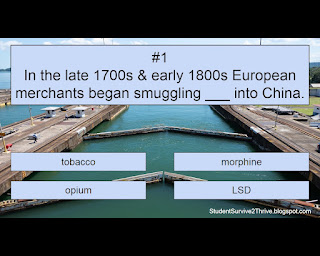 |
In the late 1700s & early 1800s European
merchants began smuggling ___ into China.
Answer choices include: tobacco, morphine, opium, LSD |
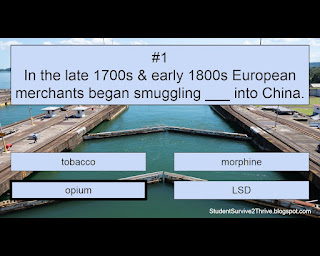 |
| The correct answer is opium. |
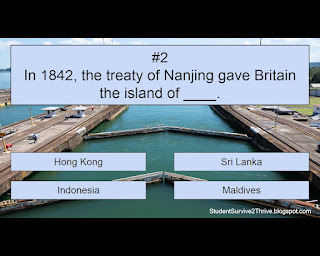 |
In 1842, the treaty of Nanjing gave Britain the island of ____.
Answer choices include: Hong Kong, Sri Lanka, Indonesia, Maldives |
 |
| The correct answer is Hong Kong. |
 |
The ___ Policy proposed China to be receptive to merchants,
protecting U.S. trading rights & China’s freedom from colonization.
Answer choices include: Open Door, Wuhan, Taiping, Free Trade Agreement |
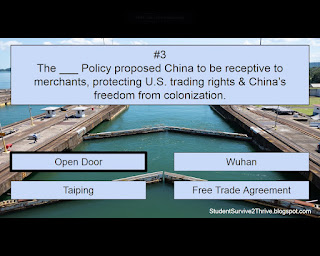 |
| The correct answer is Open Door. |
 |
In 1905, the Dowager Empress sent a group of Chinese officials
on a world tour for what purpose?
Answer choices include:
to determine trade secrets of other nations,
to study the operation of different governments,
to infiltrate germ warfare in all rivaling countries,
to seek out potential slaves from other nations |
 |
| The correct answer is: to study the operation of different governments. |
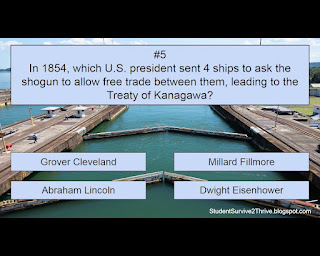 |
In 1854, which U.S. president sent 4 ships to ask the shogun
to allow free trade between them,
leading to the Treaty of Kanagawa?
Answer choices include:
Grover Cleveland, Millard Fillmore, Abraham Lincoln, Dwight Eisenhower |
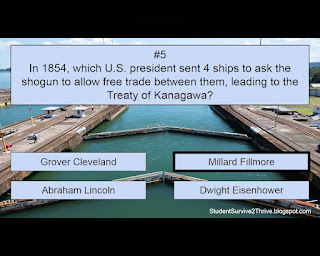 |
| The correct answer is Millard Fillmore. |
 |
Japan’s emperor, Mutsuhito, led Japan to modernize.
Which of the following did Japan do under his rule?
Answer choices include:
Create a constitution modeled after Germany,
Adopt Amercia’s idea of a universal public education system,
Imitate Britain’s navy & Germany’s army,
All of these |
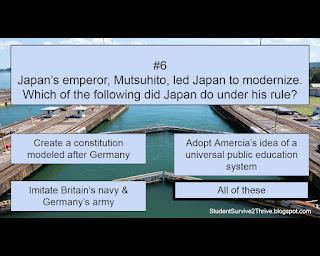 |
| The correct answer is all of these. |
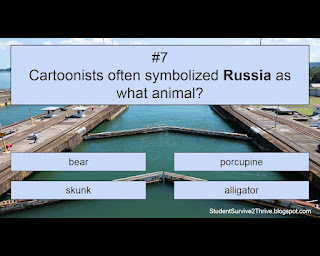 |
Cartoonists often symbolized Russia as what animal?
Answer choices include: bear, porcupine, skunk, alligator |
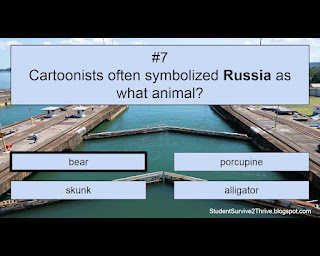 |
| The correct answer is bear. |
 |
In the early 1900s, Japan annexed ___ and took control of schools,
the press, private business, and farmland.
Answer choices include: China, Taiwan, Mongolia, Korea |
 |
| The correct answer is Korea. |
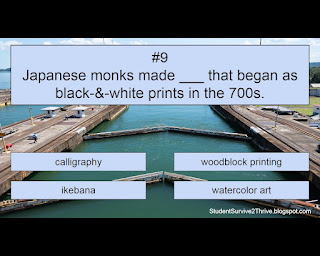 |
Japanese monks made ___ that began as black-&-white prints in the 700s.
Answer choices include: calligraphy, woodblock printing, ikebana, watercolor art |
 |
| The correct answer is woodblock printing. |
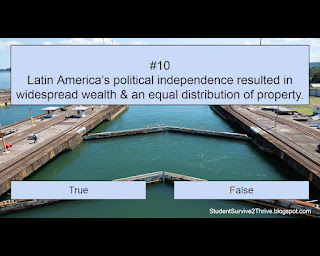 |
Latin America’s political independence resulted in widespread
wealth & an equal distribution of property.
Answer choices include: true, false |
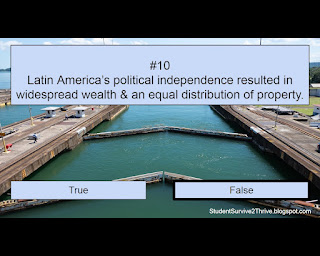 |
| The correct answer is false. |
 |
___ is when debt is accumulated & passed
through generations via “free” workers
who are like slaves in many ways.
Answer choices include:
Legacy, Caudillos, Capitalism, Peonage |
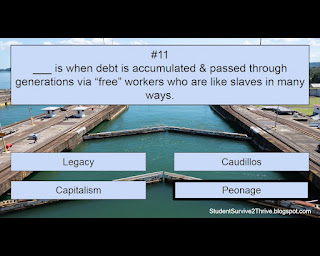 |
| The correct answer is Peonage. |
 |
Which of the following was NOT a U.S. territory in 1901?
Answer choices include: Guam, Cuba, Puerto Rico, the Philippines |
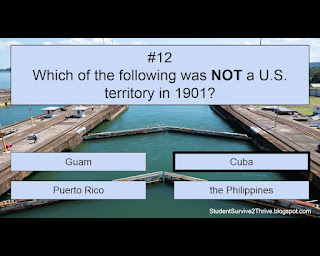 |
| The correct answer is Cuba. |
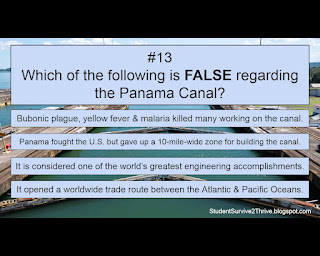 |
Which of the following is FALSE regarding the Panama Canal?
Answer choices include:
Bubonic plague, yellow fever & malaria killed many working on the canal.
Panama fought the U.S. but gave up a 10-mile zone for building the canal.
It is considered one of the world’s greatest engineering accomplishments.
It opened a worldwide trade route between the Atlantic & Pacific Oceans. |
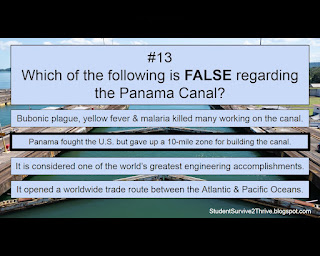 |
| The correct answer is: Panama fought the U.S. but gave up a 10-mile zone for building the canal. |
 |
In 1904, which U.S. president issued a corollary
to the Monroe Doctrine to become
an “international police power” in the Western Hemisphere?
Answer choices include:
Theodore Roosevelt, Lyndon Johnson, Franklin D. Roosevelt, Ronald Reagan |
 |
| The correct answer is Theodore Roosevelt. |
 |
In the 1848 Treaty of Guadalupe Hidalgo, the U.S. received from Mexico what is now
the state of ___ along with the American Southwest.
Answer choices include: Florida, Wyoming, Washington, California |
 |
| The correct answer is California. |
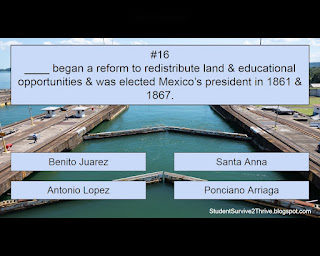 |
____ began a reform to redistribute land & educational opportunities
& was elected Mexico’s president in 1861 & 1867.
Answer choices include: Benito Juarez, Santa Anna, Antonio Lopez, Ponciano Arriaga |
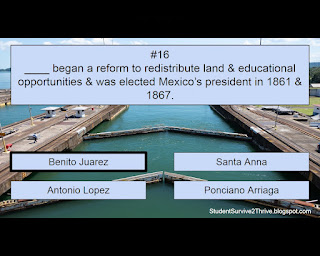 |
| The correct answer is Benito Juarez. |
 |
Porfirio Diaz controlled by “pan o palo.”
What does this mean in English?
Answer choices include:
pants or power, dollars or coins, bread or the club, one for all |
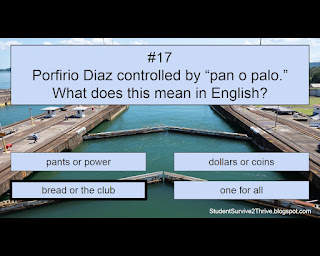 |
| The correct answer is: bread or the club. |
 |
Emiliano Zapata called for landowners to give up ___
of their land for redistribution to the peasants.
Answer choices include: all, 3/4, 1/3, 1/10 |
 |
| The correct answer is 1/3. |
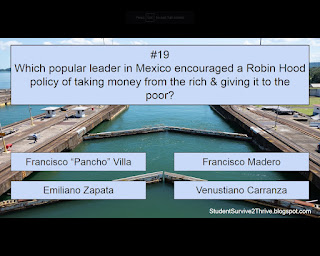 |
Which popular leader in Mexico encouraged a Robin Hood policy of taking money
from the rich & giving it to the poor?
Answer choices include: Francisco "Pancho" Villa, Francisco Madero,
Emiliano Zapata, Venustiano Carranza |
 |
| The correct answer is Francisco "Pancho" Villa |
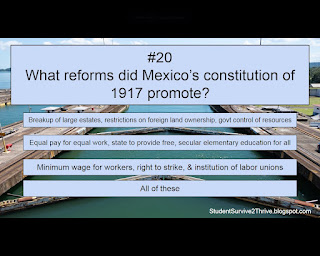 |
What reforms did Mexico’s constitution of 1917 promote?
Answer choices include:
Breakup of large estates, restrictions on foreign land ownership & govt control of resources,
Equal pay for equal work, state to provide free, secular elementary education for all,
Minimum wage for workers, right to strike, & institution of labor unions,
All of these |
 |
| The correct answer is all of these. |
 |
| Find more resources at StudentSurvive2Thrive.blogspot.com |












































No comments:
Post a Comment
Thanks for reading my article and sending your comment! Please note that I do not place links to other web sites on this blog.
Note: Only a member of this blog may post a comment.